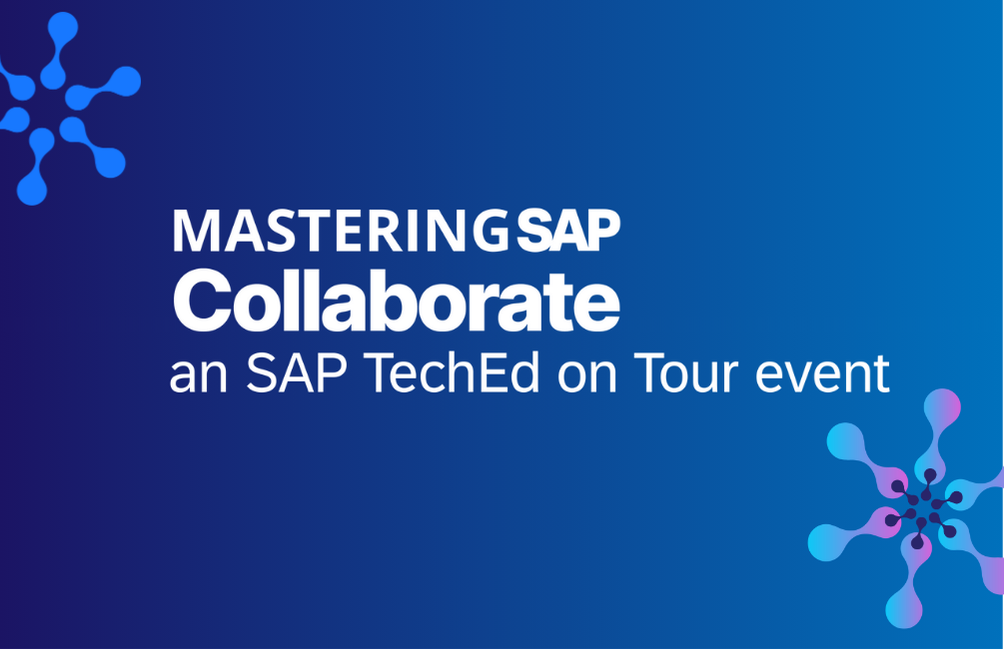Meet the Intelligent ERP: Live Q&A with SAP S/4HANA Cloud Executives on Continuous Innovation, Intelligent Use Cases & Customer Success
As more businesses than ever discover the benefits of the cloud, SAP delivers with SAP S/4HANA Cloud, a cloud ERP that combines unique industry expertise with unmatched technological innovation. Thanks to its cloud deployment, your organization can be up and running within a matter of weeks – and keep the pace moving forward. Built around an intelligent core and leveraging real-time data, it allows you to innovate at your own speed.
Explore the intelligent ERP in the cloud in this live Q&A. Learn how it can accelerate your digital value creation and how customers across industries benefit from latest innovation today.
Read the Q&A transcript with SAP S/4HANA Cloud executives Toby Davison, Özgür Otluoglu, and Marco Valencia to explore SAP S/4HANA Cloud’s capabilities and the business benefits that come from its continuous innovation. Get insights into the latest trends, like machine learning, predictive analytics and digital assistants, and how your business can derive value from them. Ask your specific questions such as:
Explore related questions
Meet the panelists:
 Özgür Otluoglu, GVP SAP S/4HANA Cloud Service Portfolio
Özgür Otluoglu, GVP SAP S/4HANA Cloud Service Portfolio
Özgür Otluoglu is GVP for the S/4HANA Cloud service portfolio covering initial deployment and continuous value engineering, as well as the global roll out and delivery of these services. He brings 18 years of consulting experience, and has worked for PricewaterhouseCoopers and IBM prior to joining SAP in 2010.
 Marco Valencia , VP SAP S/4HANA Cloud Product Management & Co-Innovation at SAP
Marco Valencia , VP SAP S/4HANA Cloud Product Management & Co-Innovation at SAP
Marco Valencia is Vice President of the SAP S/4HANA Cloud Product Management & Co-Innovation Team for the Americas. He is responsible to support the overall customer adoption for SAP S/4HANA Cloud by assessing customer and market requirements and defining SAP´s solutions strategy. He has over 21 years of experience focused on customer advocacy, product management, implementation, upgrades and value engineering of SAP Solutions. Marco joined SAP in 1996.
If you missed the chat or need a refresher, you may view the chat replay or read the edited transcript below.
Transcript:
Matthew Shea: Welcome to today’s Q&A, “Meet the Intelligent ERP: Live Q&A with SAP S/4HANA Cloud Executives on Continuous Innovation, Intelligent Use Cases & Customer Success.” In this hour, you will learn about SAP S/4HANA Cloud and how it can help you create a platform for rapid, continuous innovation, gain instant access to real-time information, and execute with confidence gained from unique insights across your entire enterprise.
I’m excited to introduce our panel of executives – they will provide expertise across a broad range of topics.
Marco Valencia is the VP of the SAP S/4HANA Cloud Product Management & Co-Innovation Team for the Americas and can answer questions related to the product strategy & roadmap, functional scope, and differences between S/4HANA Cloud and the on-premise offering.
Özgür Otluoglu is the VP for S/4HANA Cloud Service Portfolio and can cover topics related to implementation and how SAP Services can drive continuous innovation adoption and support partner-led implementations.
For more information on SAP S/4HANA Cloud, please visit www.sap.com/s4hanacloud.
Matthew Shea: Before we cover the user questions, let us start out with a question for the panelists: “What is intelligent ERP and why should customers consider SAP S/4HANA Cloud?”
Özgür Otluoglu: Public cloud has many advantages from security to innovation adoption to enhanced user experience. S/4HANA Cloud provides continuous innovation built in. Customers don’t have to wait for an expensive upgrade, but can add incremental scope continuously.
Marco Valencia: Intelligent ERP will allow customers to have the benefits of automation and intelligence when doing business. This means S/4HANA Cloud includes concepts like machine learning and a digital assistant (co-pilot) to help them make better decisions and get better insights when working with the system.
Comment From kamal: How much customization is possible when using SAP S/4HANA Cloud?
Marco Valencia: S/4HANA cloud provides a concept called self-service configuration (guided configuration). This is a set of Fiori apps that are used to guide your configuration.
S/4HANA Cloud can be configured only by using the activities available in the guided configuration.
Access to the “SPRO” : IMG is not accessible to cloud customers.
Comment From Jay: How can SAP support us throughout an S/4HANA Cloud project?
Özgür Otluoglu: Hi Jay, SAP has multiple ways to support your implementations:
– Trial System Access: provides understanding of the capabilities of the solution prior to starting an implementation
– Discovery Service: provides you with a pre-project consultative approach to understanding the solution and the processes and innovations built into the product
– SAP Plan & Safeguard Service: provides customers and partners leading a project with expert guidance and QA
– Success Plans: subscription based services that allow for just-in-time services alongside the whole customer lifecycle
– Quick-Start Implementation Service: Consultative approach to the implementation by a team of SAP experts on-site and near-shore
Comment From Bhasker: Can we seamlessly integrate business custom fields from different environments (Ariba, SuccessFactors, SalesForce, WorkDay) using HCI?
Marco Valencia: S/4HANA has pre-delivered integration with C4C, Ariba, Concur, Fieldglass, and SuccessFactors. For Workday and SalesForce we provide available APIs, so customers can integrate these solutions using the Integration Services from SAP Cloud Platform.
Comment From kamal: With SAP S/4HANA Cloud, how do the role and responsibilities of SAP functional and SAP technical experts change?
Özgür Otluoglu: The cloud approach is about simplification in terms of technical expertise needed to adopt innovation. Roles will accordingly shift from technical to functional and functional to process-consulting and change management. Fit to standard is replacing design, and guided self-configuration is replacing expert-driven setup.
Comment From Roman Khromin: What is the integration landscape offered for Cloud? How can we enable S/4HANA Cloud to “talk” to other on-premise systems, especially when there are strong restrictions on inbound traffic through the company’s firewalls?
Marco Valencia: We offer available APIs. We call them Whitelisted APIs as we need to certify that these APIs will work after our quarterly innovation cycles, so they go through a rigorous process of testing. We then use the SAP Cloud Platform Integration Services for communication. For connection to on-premise systems, we use SAP Cloud Connector, which allows you to have a secure connection to on-premise systems.
Comment From Raj Krish: Any time we say cloud (in general), are we always referring to ‘public’ cloud?
Özgür Otluoglu: Yes, it is common that “cloud” in software terms means “public cloud,” whereas private cloud / cloud hosted infrastructure is titled explicitly.
Comment From Nicholas Guglielmo: What is your primary medium for promoting your cloud offerings?
Özgür Otluoglu: Web is the biggest one, I would say, supported by conferences, blogs, SAPPHIRE, TV, YouTube …
Comment From RupaliS: What basic preparations are needed before we migrate to cloud?
Marco Valencia: S/4HANA Cloud uses an approach called “Fit to Standard” that means you need to review the scope of all processes we offer. Cloud doesn’t allow modifications like on-premise, so you really need to look at retrofitting your business requirements with the best practices we offer. For data migration we have a tool called the SAP Migration Cockpit that allows customers to migrate legacy data using a very easy-to-use tool based on predefined templates.
Comment From Raj Krish: Which type of customers go for the SAP Cloud version vs. the on-premise version?
Özgür Otluoglu: We have customers from all industries, geographic locations, and sizes. Our target market is large enterprises with 1500 or more users, but we also have many professional services customers implementing a project based service scope.
Comment From Terry: What is the innovation cycle/how often is SAP S/4HANA Cloud updated?
Özgür Otluoglu: A new release is delivered every quarter.
Comment From Naveen: What is included in the SAP S/4HANA Cloud subscription?
Özgür Otluoglu: The subscription includes the latest software, infrastructure, security, integration capabilities, and support, as well as continuous updates every quarter.
Comment From Roman Khromin: It would be useful to clarify what customization options are and aren’t available in the cloud?
Marco Valencia: From a configuration perspective, we used a new, state-of-the-art technology called “Self-Service Configuration,” which allows customers to configure the Cloud based upon a fit to standard process. This Self-Service Configuration contains a process called Content Lifecycle Management that allow customers to protect configurations from innovation upgrades. For extensibility we offer two types. In-App allows us to add custom fields, custom tables, some logic, etc. Then we have side-by-side extensibility using the SAP Cloud Platform.
Comment From Josh: What is the functional scope of SAP S/4HANA Cloud?
Marco Valencia: S/4HANA Cloud has a vast ERP functional scope, from finance, controlling, procurement, etc.:
You can also view: https://rapid.sap.com/bp
Comment From Jerry: I would like to learn more about native HANA programming and connecting HANA to R. Are there any OPENSAP or SAP Learning Hub Courses you could recommend?
Marco Valencia: R is an open source programming language and software environment for statistical computing and graphics that is supported by the R Foundation for Statistical Computing.
While R Integration is not part of the SAP S/4HANA Cloud offering today, there is an integration guide for integrating SAP HANA with R.
SAP HANA R Integration Guide: https://help.sap.com/viewer…
Additional Blogs: https://www.r-bloggers.com/…
Comment From Raj Krish: Do industry solutions (for ex: automotive) provide the same functionality between the cloud version and the on-premise version? If not, what would be the main difference?
Özgür Otluoglu: We currently have 2 scope areas that have an industry flavor: professional services and discrete manufacturing. However, most of the solution is cross-industry. We will add more industry flavors moving forward.
Comment From Daniel: Why should customers consider SAP S/4HANA Cloud?
Marco Valencia: Why cloud?
To help customers drive their digital business transformation with the simplicity of the cloud.
It gives customers the opportunity to deploy real hybrid scenarios — combining on-premise and cloud solutions — for unprecedented IT flexibility and accelerated business innovation.
Customers will now also be able to run their entire enterprise in the cloud with a digital core comprising the most essential scenarios, including finance, accounting, controlling, procurement, sales, manufacturing, plant maintenance, project system, and product lifecycle management. Existing and new customers will be able to adopt the cloud edition of SAP S/4HANA via a simple subscription model. SAP aims to support customers in their journey with predefined migration, system conversion in the cloud, guided configuration, and deployment packages to drive quicker time to value.
Don’t forget the added benefit of opex and low TCO.
Comment From Matthew: What is the main difference between SAP S/4HANA on-premise vs. SAP S/4HANA Cloud?
Marco Valencia: Simply put: https://www.sap.com/product…
Comment From Raj Krish: Thank you for organizing this. Special thanks to Matthew and the panelists for taking the time and answering. Very helpful!! Kudos!!!
Marco Valencia: You’re welcome!
Comment From Ken: How are other companies approaching upgrades to S/4HANA Cloud? Can you share experiences regarding the move from ECC 6.0?
Marco Valencia: Normally moving to SAP S/4HANA is a greenfield implementation involving data migration with our Data Migration Cockpit. Innovation upgrades (quarterly) are handled directly by SAP. Customers will need just to test the business. We recommend that our customers follow the SAP Activate methodology to get this done.
Comment From Satya: I would like to know how WRICEF requirements are addressed in S/4 HANA Cloud.
Özgür Otluoglu: Workflow: Some processes are covered, e.g. procurement. We are building more workflow capabilities.
Reporting: Cloud Analytics integration is available to extend standard reporting.
Interfaces: We publish APIs that customers and partners can use for integrating with any 3rd-party system using SAP Cloud Platform.
Conversion: S/4HANA Cloud comes with a built-in migration tool that allows for uploading data for many objects.
Extensibility: SAP S/4HANA Cloud has an extensive extensibility concept and related capabilities. This covers both in-app extensibility where you can add fields and logic into the solution, and side-by-side extensibility where you develop using SAP Cloud Platform and integrate using HCI.
Forms: Adobe lifecycle designer is used so that standard delivered forms can be adopted by customers.
Comment From Emilie: What would be the migration path for a customer moving from SAP ERP on-premise any DB to cloud edition for SAP S/4HANA?
Marco Valencia: Normally moving to SAP S/4HANA is a greenfield implementation involving data migration with our Data Migration Cockpit. Innovation upgrades (quarterly) are handled directly by SAP. Customers will need just to test the business. We recommend that our customers follow the SAP Activate methodology to get this done.
Comment From Raman: What is the essential learning path for an experienced SAP SCM/ APO consultant in order to help a new or existing customer implement SAP S/4HANA for the supply chain areas planning, scheduling, & manufacturing.
Marco Valencia: First, you need to set your mind to the cloud. That means you will need to do a “Fit to Standard” vs. “Fit Gap Analysis”. There is specific training available, “SAP Training for Consultants to Onboard Customers”: https://training.sap.com/sh…
Comment From Raman: What are the steps an existing customer with an SCM/ APO system using DP, SNP, & PPDS modules should take in order to migrate to supply chain planning and scheduling on SAP S/4HANA?
Marco Valencia: Our recommendation for APO is to migrate to IBP to manage these advanced capabilities.
Comment From RupaliS: What does an S/4HANA migration to cloud mean for the SAP BASIS Consultant? How much scope would the in-house consultant have over the migration to cloud?
Özgür Otluoglu: With regards to migration, the basic tasks remain the same. The consultative approach of data analysis, data mapping, upload tests, and so on remain and still need to be performed by the project team. The tool provides a template that needs to be filled and that can be uploaded. All other tasks remain the same for cleansing and conversion to the new structure.
Comment From Dominic: How do we address bandwidth concerns between S/4HANA in the cloud and other systems on-premise?
Marco Valencia: Do you have more details? Bandwidth really depends on different factors, such as data center location, network, etc. Check this link to see how we address this in our data centers: https://www.sapdatacenter.com/
Matthew Shea: This concludes today’s chat. Thank you everyone for your questions today!
And thank you very much to Marco and Özgür for all your time and insightful answers!
As more businesses than ever discover the benefits of the cloud, SAP delivers with SAP S/4HANA Cloud, a cloud ERP that combines unique industry expertise with unmatched technological innovation. Thanks to its cloud deployment, your organization can be up and running within a matter of weeks – and keep the pace moving forward. Built around an intelligent core and leveraging real-time data, it allows you to innovate at your own speed.
Explore the intelligent ERP in the cloud in this live Q&A. Learn how it can accelerate your digital value creation and how customers across industries benefit from latest innovation today.
Read the Q&A transcript with SAP S/4HANA Cloud executives Toby Davison, Özgür Otluoglu, and Marco Valencia to explore SAP S/4HANA Cloud’s capabilities and the business benefits that come from its continuous innovation. Get insights into the latest trends, like machine learning, predictive analytics and digital assistants, and how your business can derive value from them. Ask your specific questions such as:
Meet the panelists:
 Özgür Otluoglu, GVP SAP S/4HANA Cloud Service Portfolio
Özgür Otluoglu, GVP SAP S/4HANA Cloud Service Portfolio
Özgür Otluoglu is GVP for the S/4HANA Cloud service portfolio covering initial deployment and continuous value engineering, as well as the global roll out and delivery of these services. He brings 18 years of consulting experience, and has worked for PricewaterhouseCoopers and IBM prior to joining SAP in 2010.
 Marco Valencia , VP SAP S/4HANA Cloud Product Management & Co-Innovation at SAP
Marco Valencia , VP SAP S/4HANA Cloud Product Management & Co-Innovation at SAP
Marco Valencia is Vice President of the SAP S/4HANA Cloud Product Management & Co-Innovation Team for the Americas. He is responsible to support the overall customer adoption for SAP S/4HANA Cloud by assessing customer and market requirements and defining SAP´s solutions strategy. He has over 21 years of experience focused on customer advocacy, product management, implementation, upgrades and value engineering of SAP Solutions. Marco joined SAP in 1996.
If you missed the chat or need a refresher, you may view the chat replay or read the edited transcript below.
Transcript:
Matthew Shea: Welcome to today’s Q&A, “Meet the Intelligent ERP: Live Q&A with SAP S/4HANA Cloud Executives on Continuous Innovation, Intelligent Use Cases & Customer Success.” In this hour, you will learn about SAP S/4HANA Cloud and how it can help you create a platform for rapid, continuous innovation, gain instant access to real-time information, and execute with confidence gained from unique insights across your entire enterprise.
I’m excited to introduce our panel of executives – they will provide expertise across a broad range of topics.
Marco Valencia is the VP of the SAP S/4HANA Cloud Product Management & Co-Innovation Team for the Americas and can answer questions related to the product strategy & roadmap, functional scope, and differences between S/4HANA Cloud and the on-premise offering.
Özgür Otluoglu is the VP for S/4HANA Cloud Service Portfolio and can cover topics related to implementation and how SAP Services can drive continuous innovation adoption and support partner-led implementations.
For more information on SAP S/4HANA Cloud, please visit www.sap.com/s4hanacloud.
Matthew Shea: Before we cover the user questions, let us start out with a question for the panelists: “What is intelligent ERP and why should customers consider SAP S/4HANA Cloud?”
Özgür Otluoglu: Public cloud has many advantages from security to innovation adoption to enhanced user experience. S/4HANA Cloud provides continuous innovation built in. Customers don’t have to wait for an expensive upgrade, but can add incremental scope continuously.
Marco Valencia: Intelligent ERP will allow customers to have the benefits of automation and intelligence when doing business. This means S/4HANA Cloud includes concepts like machine learning and a digital assistant (co-pilot) to help them make better decisions and get better insights when working with the system.
Comment From kamal: How much customization is possible when using SAP S/4HANA Cloud?
Marco Valencia: S/4HANA cloud provides a concept called self-service configuration (guided configuration). This is a set of Fiori apps that are used to guide your configuration.
S/4HANA Cloud can be configured only by using the activities available in the guided configuration.
Access to the “SPRO” : IMG is not accessible to cloud customers.
Comment From Jay: How can SAP support us throughout an S/4HANA Cloud project?
Özgür Otluoglu: Hi Jay, SAP has multiple ways to support your implementations:
– Trial System Access: provides understanding of the capabilities of the solution prior to starting an implementation
– Discovery Service: provides you with a pre-project consultative approach to understanding the solution and the processes and innovations built into the product
– SAP Plan & Safeguard Service: provides customers and partners leading a project with expert guidance and QA
– Success Plans: subscription based services that allow for just-in-time services alongside the whole customer lifecycle
– Quick-Start Implementation Service: Consultative approach to the implementation by a team of SAP experts on-site and near-shore
Comment From Bhasker: Can we seamlessly integrate business custom fields from different environments (Ariba, SuccessFactors, SalesForce, WorkDay) using HCI?
Marco Valencia: S/4HANA has pre-delivered integration with C4C, Ariba, Concur, Fieldglass, and SuccessFactors. For Workday and SalesForce we provide available APIs, so customers can integrate these solutions using the Integration Services from SAP Cloud Platform.
Comment From kamal: With SAP S/4HANA Cloud, how do the role and responsibilities of SAP functional and SAP technical experts change?
Özgür Otluoglu: The cloud approach is about simplification in terms of technical expertise needed to adopt innovation. Roles will accordingly shift from technical to functional and functional to process-consulting and change management. Fit to standard is replacing design, and guided self-configuration is replacing expert-driven setup.
Comment From Roman Khromin: What is the integration landscape offered for Cloud? How can we enable S/4HANA Cloud to “talk” to other on-premise systems, especially when there are strong restrictions on inbound traffic through the company’s firewalls?
Marco Valencia: We offer available APIs. We call them Whitelisted APIs as we need to certify that these APIs will work after our quarterly innovation cycles, so they go through a rigorous process of testing. We then use the SAP Cloud Platform Integration Services for communication. For connection to on-premise systems, we use SAP Cloud Connector, which allows you to have a secure connection to on-premise systems.
Comment From Raj Krish: Any time we say cloud (in general), are we always referring to ‘public’ cloud?
Özgür Otluoglu: Yes, it is common that “cloud” in software terms means “public cloud,” whereas private cloud / cloud hosted infrastructure is titled explicitly.
Comment From Nicholas Guglielmo: What is your primary medium for promoting your cloud offerings?
Özgür Otluoglu: Web is the biggest one, I would say, supported by conferences, blogs, SAPPHIRE, TV, YouTube …
Comment From RupaliS: What basic preparations are needed before we migrate to cloud?
Marco Valencia: S/4HANA Cloud uses an approach called “Fit to Standard” that means you need to review the scope of all processes we offer. Cloud doesn’t allow modifications like on-premise, so you really need to look at retrofitting your business requirements with the best practices we offer. For data migration we have a tool called the SAP Migration Cockpit that allows customers to migrate legacy data using a very easy-to-use tool based on predefined templates.
Comment From Raj Krish: Which type of customers go for the SAP Cloud version vs. the on-premise version?
Özgür Otluoglu: We have customers from all industries, geographic locations, and sizes. Our target market is large enterprises with 1500 or more users, but we also have many professional services customers implementing a project based service scope.
Comment From Terry: What is the innovation cycle/how often is SAP S/4HANA Cloud updated?
Özgür Otluoglu: A new release is delivered every quarter.
Comment From Naveen: What is included in the SAP S/4HANA Cloud subscription?
Özgür Otluoglu: The subscription includes the latest software, infrastructure, security, integration capabilities, and support, as well as continuous updates every quarter.
Comment From Roman Khromin: It would be useful to clarify what customization options are and aren’t available in the cloud?
Marco Valencia: From a configuration perspective, we used a new, state-of-the-art technology called “Self-Service Configuration,” which allows customers to configure the Cloud based upon a fit to standard process. This Self-Service Configuration contains a process called Content Lifecycle Management that allow customers to protect configurations from innovation upgrades. For extensibility we offer two types. In-App allows us to add custom fields, custom tables, some logic, etc. Then we have side-by-side extensibility using the SAP Cloud Platform.
Comment From Josh: What is the functional scope of SAP S/4HANA Cloud?
Marco Valencia: S/4HANA Cloud has a vast ERP functional scope, from finance, controlling, procurement, etc.:
You can also view: https://rapid.sap.com/bp
Comment From Jerry: I would like to learn more about native HANA programming and connecting HANA to R. Are there any OPENSAP or SAP Learning Hub Courses you could recommend?
Marco Valencia: R is an open source programming language and software environment for statistical computing and graphics that is supported by the R Foundation for Statistical Computing.
While R Integration is not part of the SAP S/4HANA Cloud offering today, there is an integration guide for integrating SAP HANA with R.
SAP HANA R Integration Guide: https://help.sap.com/viewer…
Additional Blogs: https://www.r-bloggers.com/…
Comment From Raj Krish: Do industry solutions (for ex: automotive) provide the same functionality between the cloud version and the on-premise version? If not, what would be the main difference?
Özgür Otluoglu: We currently have 2 scope areas that have an industry flavor: professional services and discrete manufacturing. However, most of the solution is cross-industry. We will add more industry flavors moving forward.
Comment From Daniel: Why should customers consider SAP S/4HANA Cloud?
Marco Valencia: Why cloud?
To help customers drive their digital business transformation with the simplicity of the cloud.
It gives customers the opportunity to deploy real hybrid scenarios — combining on-premise and cloud solutions — for unprecedented IT flexibility and accelerated business innovation.
Customers will now also be able to run their entire enterprise in the cloud with a digital core comprising the most essential scenarios, including finance, accounting, controlling, procurement, sales, manufacturing, plant maintenance, project system, and product lifecycle management. Existing and new customers will be able to adopt the cloud edition of SAP S/4HANA via a simple subscription model. SAP aims to support customers in their journey with predefined migration, system conversion in the cloud, guided configuration, and deployment packages to drive quicker time to value.
Don’t forget the added benefit of opex and low TCO.
Comment From Matthew: What is the main difference between SAP S/4HANA on-premise vs. SAP S/4HANA Cloud?
Marco Valencia: Simply put: https://www.sap.com/product…
Comment From Raj Krish: Thank you for organizing this. Special thanks to Matthew and the panelists for taking the time and answering. Very helpful!! Kudos!!!
Marco Valencia: You’re welcome!
Comment From Ken: How are other companies approaching upgrades to S/4HANA Cloud? Can you share experiences regarding the move from ECC 6.0?
Marco Valencia: Normally moving to SAP S/4HANA is a greenfield implementation involving data migration with our Data Migration Cockpit. Innovation upgrades (quarterly) are handled directly by SAP. Customers will need just to test the business. We recommend that our customers follow the SAP Activate methodology to get this done.
Comment From Satya: I would like to know how WRICEF requirements are addressed in S/4 HANA Cloud.
Özgür Otluoglu: Workflow: Some processes are covered, e.g. procurement. We are building more workflow capabilities.
Reporting: Cloud Analytics integration is available to extend standard reporting.
Interfaces: We publish APIs that customers and partners can use for integrating with any 3rd-party system using SAP Cloud Platform.
Conversion: S/4HANA Cloud comes with a built-in migration tool that allows for uploading data for many objects.
Extensibility: SAP S/4HANA Cloud has an extensive extensibility concept and related capabilities. This covers both in-app extensibility where you can add fields and logic into the solution, and side-by-side extensibility where you develop using SAP Cloud Platform and integrate using HCI.
Forms: Adobe lifecycle designer is used so that standard delivered forms can be adopted by customers.
Comment From Emilie: What would be the migration path for a customer moving from SAP ERP on-premise any DB to cloud edition for SAP S/4HANA?
Marco Valencia: Normally moving to SAP S/4HANA is a greenfield implementation involving data migration with our Data Migration Cockpit. Innovation upgrades (quarterly) are handled directly by SAP. Customers will need just to test the business. We recommend that our customers follow the SAP Activate methodology to get this done.
Comment From Raman: What is the essential learning path for an experienced SAP SCM/ APO consultant in order to help a new or existing customer implement SAP S/4HANA for the supply chain areas planning, scheduling, & manufacturing.
Marco Valencia: First, you need to set your mind to the cloud. That means you will need to do a “Fit to Standard” vs. “Fit Gap Analysis”. There is specific training available, “SAP Training for Consultants to Onboard Customers”: https://training.sap.com/sh…
Comment From Raman: What are the steps an existing customer with an SCM/ APO system using DP, SNP, & PPDS modules should take in order to migrate to supply chain planning and scheduling on SAP S/4HANA?
Marco Valencia: Our recommendation for APO is to migrate to IBP to manage these advanced capabilities.
Comment From RupaliS: What does an S/4HANA migration to cloud mean for the SAP BASIS Consultant? How much scope would the in-house consultant have over the migration to cloud?
Özgür Otluoglu: With regards to migration, the basic tasks remain the same. The consultative approach of data analysis, data mapping, upload tests, and so on remain and still need to be performed by the project team. The tool provides a template that needs to be filled and that can be uploaded. All other tasks remain the same for cleansing and conversion to the new structure.
Comment From Dominic: How do we address bandwidth concerns between S/4HANA in the cloud and other systems on-premise?
Marco Valencia: Do you have more details? Bandwidth really depends on different factors, such as data center location, network, etc. Check this link to see how we address this in our data centers: https://www.sapdatacenter.com/
Matthew Shea: This concludes today’s chat. Thank you everyone for your questions today!
And thank you very much to Marco and Özgür for all your time and insightful answers!








